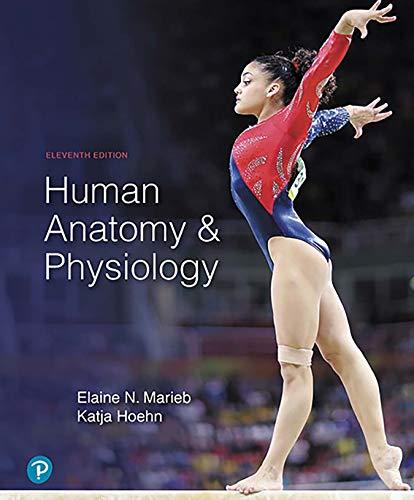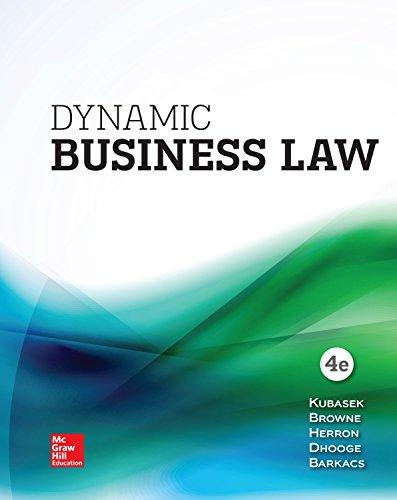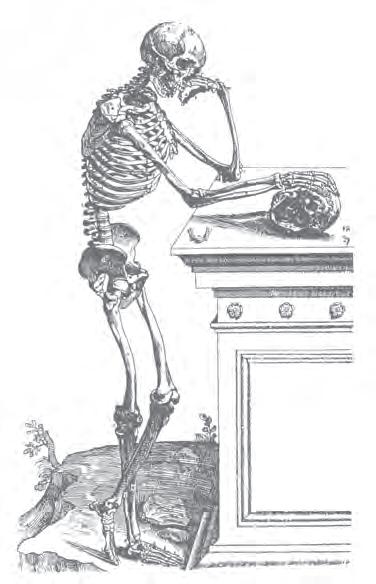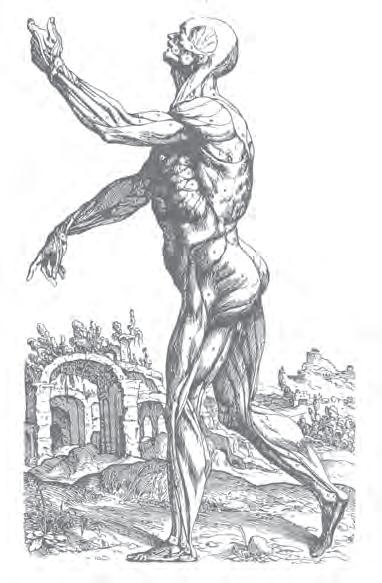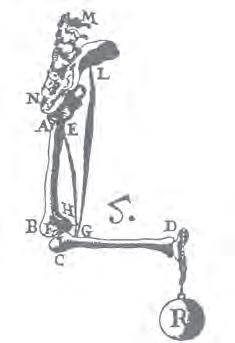Preface
No earthly creation is as intricate, versatile, or mysterious as the human body. Our bodies perform countless functions that ensure our existence. Of all the body’s functions, movement is arguably the most essential, for without movement, the human body could not survive. With movement, the body flourishes. At one end of the movement spectrum, the capacity for purposeful movement allows us to maintain fundamental physiological processes; at the other end, it allows us to pursue the limits of athletic and artistic expression.
For those involved in the many areas of human health and performance, knowledge of the body’s structure and function is essential. Students in these areas undoubtedly have taken introductory courses in human anatomy. All too often, however, these courses (which attempt to cover all of the body’s systems in a single academic term) provide students with the basics of structural anatomy but offer limited exposure to the elegance and complexity of the body’s functional movement anatomy
From my experience teaching human anatomy, kinesiology, and biomechanics over the past three decades, I can attest to the unfortunate fact that some students emerge from their introductory anatomy experience with limited competency in applying their anatomical knowledge to human movement problems. These students have learned what I refer to (not too euphemistically, and only somewhat kiddingly) as “dead anatomy.”
The purpose of this book is to bring anatomy to life by exploring the marvelous potential of the human body to express itself through movement and to provide students with the information and skills they need to appreciate and assess dynamic human anatomy.
Organization
This book, the successor edition to Dynatomy: Dynamic Human Anatomy (Whiting & Rugg, 2006), has been developed primarily for students who already have taken, or currently are taking, an introductory course in human anatomy and who need a more detailed exposure to concepts of human movement anatomy. These students include those in the fields of exercise science and human movement studies, kinesiology, biomechanics, physical education, coaching, athletic training, ergonomics, and the health sciences (e.g., medicine, physical therapy).
Given the amount of material presented and memorized in introductory anatomy courses, it is neither unusual nor unexpected that students forget many of the details. Thus, part I (Anatomical Foundations) provides a concise review of relevant anatomical information and neuromechanical concepts. Part I begins in chapter 1 (Introduction to Human Anatomy and Movement) with an introduction to the dynamics of human movement and essentials of anatomical structure. The chapter presents a brief overview of motor behavior, including lifespan motor development, motor control, and motor learning, and it establishes a contextual framework for later discussion of specific movements and populations.
Chapter 2 (Osteology and the Skeletal System) describes the microstructure and macroscopic morphology of bone and the organization of the skeletal system. It also identifies specific bones and bony landmarks.
Part I continues in chapter 3 (Joint Anatomy and Function) with a discussion of joint structure, function, and motion, along with a description of major joints of the extremities and spine. Chapter 4 (Skeletal Muscle) begins with a discussion of the structure and function of skeletal muscle and the basic physiology and mechanics of muscle action. The chapter continues with exploration of muscle actions; voluntary, reflex, and stereotypical movements; nervous system control of muscle action; and factors (e.g., muscle length and velocity, fiber
type, and muscle architecture) that affect muscle force production. It concludes with a presentation of the primary muscles responsible for the production and control of human movement.
With the requisite anatomical and neuromechanical foundations in place, part II (Biomechanics and Movement Control) provides the essentials of a dynamic approach to movement. This part begins in chapter 5 (Biomechanics) with a review of mechanical concepts essential to an understanding of human movement. Chapter 6 (Muscular Control of Movement and Movement Assessment) explains the muscle control formula, a set of simple steps used to identify the muscles and types of muscle actions responsible for producing or controlling human movements. Numerous examples, using simple movement patterns, demonstrate the utility of the formula. Mastery of the muscle control formula provides a valuable tool for independent assessment of muscle action across a broad spectrum of human movements. Chapter 6 concludes with consideration of several important topics relevant to movement assessment. These include single-joint versus multijoint movements, coordination, movement efficiency, and assessment of movement.
Part III (Fundamentals of Movements) begins in chapter 7 (Posture and Balance) with a discussion of the types and functions of posture and balance, mechanisms of postural control, postural alterations and perturbations, developmental considerations, life-span aspects of balance, and postural dysfunction. Chapter 8 (Gait) explores various aspects of walking and running gait. Part III concludes with chapter 9 (Basic Movement Patterns), which examines the fundamental movement patterns of jumping, kicking, lifting, throwing, and striking.
With the anatomical, biomechanical, and basic movement pattern foundations in place, part IV (Movement Applications) discusses movement-related aspects of strength and conditioning applications (chapter 10), sport and dance applications (chapter 11), clinical applications (chapter 12), and ergonomics applications (chapter 13).
One of the primary goals of this book has been to include concepts not found in many traditional anatomy texts, concepts that emphasize function and application. An understanding of the material covered will enhance your preparation for work in the many areas of human movement. To assist you is a comprehensive glossary that defines hundreds of important terms and concepts. Terms boldfaced in the text can be found in the glossary. Each chapter also includes objectives and critical thinking questions to guide and challenge students, as well as suggested readings for further study.
Updates to the Second Edition
The second edition has been updated to include recent research and citations. Additional sidebars have been included to present applications of concepts and movement-related research in biomechanics. Three new chapters have been added to expand on applications in the areas of strength and conditioning (chapter 10), clinical issues (chapter 12), and ergonomics (chapter 13). In addition, chapter 11 (Sport and Dance Applications) has been expanded to cover movement mechanics in baseball and softball, basketball, American football, golf, soccer, tennis, and volleyball.
Student Resources
Students have access to a web study guide that provides several learning aids:
• Summary of articulations for the spine and upper and lower extremities
• Tables that provide the origin, inser tion, action, and innervation for all major muscle groups
• Interactive practice problems that allow students to apply the muscle control formula discussed in chapter 6
• Critical thinking questions
The web study guide is available at www.HumanKinetics.com/DynamicHumanAnatomy.
Instructor Resources
New to this edition is a full array of instructor resources:
• Presentation package: More than 270 slides present the key concepts from the chapters, including select figures and tables. These slides can be updated to fit unique lecture and classroom needs.
• Image bank: The image bank includes most of the figures and tables from the text. These images can be used to supplement PowerPoint slides, lectures, student handouts, and so on.
• Instructor guide: The instructor guide provides an introduction on how to use the ancillaries, suggestions for student activities, a sample syllabus, and chapter-specific files that include summaries and lecture outlines. It also includes the answers to the critical thinking questions in the web study guide.
• Test package: The test package includes 330 questions that instructors can use to build quizzes to test student understanding.
The instructor ancillaries are available at www.HumanKinetics.com/DynamicHumanAnatomy.
Final Thoughts
Please keep in mind that the material in this text is only a beginning. Consideration of any one of the many topics presented could be expanded to fill a chapter, or even a book, of its own. I make no pretense of having exhaustively covered any of the topics, but rather have sought to present a concise introduction to many of the fascinating areas of human movement. This book will have served its purpose well if you emerge with an appreciation for human movement that is more wondrous and less mysterious than when your journey began. In the words of British author Laurence Sterne, “So much of motion, is so much of life, and so much of joy” (1980, p. 354).
This page intentionally left blank.
Introduction to Human Anatomy
Anatomy, simply defined, is the study of the structure of organisms. The term derives from the Greek anatome, which means “to dissect” or “to cut.” The organism considered here is the human organism. Historically, dissection has been a primary means of discovery about the structure of the human organism, and it remains a useful educational tool in training professionals in the health sciences (e.g., medicine, physical therapy). However, in recent decades, technological advances of many kinds (e.g., MRI, CAT scans) have allowed us to better understand the body’s structure without cutting it open.
Anatomy is an expansive science that encompasses many branches, or subdivisions. Some of these subdivisions are described in table 1.1. In establishing our anatomical foundation for study of human movement, we focus on gross (macroscopic) anatomy, systemic anatomy (especially the skeletal, muscular, and nervous systems), regional anatomy as it relates to specific movement patterns, and, most importantly, functional anatomy.
Although anatomy is our focus, the related area of physiology, which deals with the functions of the body parts and systems, deserves mention. Anatomy and physiology are closely related, and study of one without consideration of the other makes little sense. We begin by presenting, in elementary terms, the origin, development, and structure of the body’s components and then show how the parts are both structurally and functionally interconnected.
We begin with an overview of human movement, followed by an introduction to concepts of functional anatomy. These anatomical concepts form a necessary foundation for your understanding of dynamic human anatomy.
TABLE 1.1 Subdivisions of Anatomy
Anatomy subdivision
Gross (macroscopic)
Microscopic anatomy
Systemic anatomy
Regional anatomy
Functional anatomy
Surface anatomy
Description
anatomyStudy of structures without the aid of a microscope
Study of structures using microscopic techniques
Study of specific body systems (e.g., skeletal, muscular, nervous, respiratory, cardiovascular)
Study of specific body regions (e.g., head, extremities)
Study of how body systems (e.g., skeletal, muscular, nervous) work cooperatively to perform various functions
Study of landmarks on the surface of the body
Developmental anatomyStudy of structural development across the life span, from fertilization to death
Embryology
Histology
Cytology
Study of development from fertilization through the 8th week in utero
Microscopic study of tissue structure
Microscopic study of cell structure
Applying the Concept
Vesalius
Some of the most admired anatomical treasures of the Renaissance were drawn by Andreas Vesalius (1514-1564). His master work, De Humani Corporis Fabrica (1543), stands as one of the great volumes in the history of modern science. In this work, Vesalius blended text with picture into a truly integrated presentation of his understanding of human anatomy.
THE ANATOMICAL legacy of Vesalius.E7051/Whiting/F01.01/587679/mh-R1
Introduction to Human Movement
Movement is a fundamental behavior essential for life itself. Life processes such as blood circulation, respiration, and muscle contraction require motion, as do activities such as walking, bending, and lifting. The human organism seeks, consciously or not, to move. Children, in particular, provide clear evidence of the inherent nature of humans to move. They never seem to stop. Even as we age and slow down, movement remains an essential part of our lives. As noted by French scientist and philosopher Blaise Pascal (1623-1662), “Our nature consists in motion; complete rest is death” (Pascal & Krailsheimer, 1995, p. 211).
At one end of the spectrum, the capacity for purposeful movement supports basic physiological processes; at the other end, movement allows us to explore the limits of athletic and artistic expression. Limited movement, such as when a person is bedridden or elects a sedentary lifestyle, can contribute to adverse health conditions such as cardiovascular disease, diabetes, and cancer. Thus our ability to move, or the choice to limit movement, may contribute, either directly or indirectly, to our susceptibility to disease and injury.
The study of human movement across all its dimensions is known as kinesiology (Gk. kinesis, fr. kinein “to move”). Kinesiology is a broad discipline that encompasses both the science and art of human movement. It draws from many related disciplines, including anatomy, physiology, biomechanics, motor behavior, and psychology, together with clinical and applied disciplines such as medicine, physical therapy, engineering, and physical education. A primary goal of studying kinesiology is to identify the underlying mechanisms and consequences of human movement.
The range of human movements is broad and complex. Some movements, such as throwing, consist of a single episode; others, such as walking, involve repetitive movement cycles. And none of us moves in the same way, even while doing the same thing. Each person, for example, adopts a unique walking pattern based on individual structure, purpose, and style. This can be seen in the common experience of viewing a person’s silhouette in the distance and knowing who it is by the way she walks, long before we recognize her by facial or body features. Something in the way she moves tells us who she is.
Movement Across the Life Span
As we navigate life’s journey, each of us becomes aware of our own movement capabilities and limitations. As children, we progress from immobility to crawling, walking, running, and jumping. With age, we grow larger and stronger, and typically become more proficient in our movement patterns throughout most of our lives. Our later years may be characterized by movement pattern changes due to muscle strength decreases, fatigue, nervous system declines, postural changes, injury, disease, and environmental factors. One thing is clear—our ability to move changes across the life span. These changes can enhance movement potential, as when a child grows and develops, or limit movement, as in the case where injury, disease, or age-related functional declines cause a deterioration in movement capacity. Given the myriad changes to our movements from cradle to grave, we emphasize a life-span perspective throughout this book.
Anatomical changes that occur from day to day are barely detectable, if at all, but as days turn to weeks, weeks to months, and months to years, changes become evident. These changes may be due to growth (e.g., an adult is larger and stronger than a child); physical conditioning (e.g., an athlete performs better after a strength or endurance training program); injury or disease (e.g., the growth of a child’s bone may be affected by a serious fracture); or a variety of environmental, sociological, psychological, or cultural influences.
Each of us changes in countless unique ways throughout our lives. These changes directly affect our potential and capacity to move. The chapters that follow take a life-span approach to functional anatomy and human movement and show many ways in which movement is affected by our time and place along life’s journey. The acquisition and refinement of movement skills across the life span are examined through the study of motor behavior and its subareas: motor control, motor learning, and motor development.
Motor Behavior
In the context of human movement, the term motor describes things related to a muscle, nerve, or brain center involved in producing or controlling movements. Motor behavior is an umbrella term that encompasses several specialized areas related to neuromuscular control of movement: motor control, motor learning, and motor development. Each of these areas contributes to our understanding of human movement.
Each area of motor behavior typically encompasses a distinctive time frame. Motor control covers events with very short time intervals; motor learning involves times of hours, days, and weeks; and motor development addresses events over months, years, and even decades. For example, to control the muscles involved in throwing a ball, the nervous system sends signals to the shoulder and arm. These signals may last for a fraction of a second. Learning to throw may take days or weeks. And to see developmental changes in throwing from child-
hood to adulthood, we need to observe the task across many years. Though these areas are clearly related, we consider each in turn.
Motor Control
Motor control is the study of the neural, physical, and behavioral aspects of movement (Schmidt & Lee, 2011). More specifically, motor control refers to how the body’s systems organize and control muscles involved in movement. The system primarily involved in control is the nervous system, which consists of the brain, spinal cord, and peripheral nerves emerging from the cord.
Research in Mechanics
The Legacy of Borelli
In the history of science, the name Giovanni Alfonso Borelli (1608-1679) usually does not appear on lists with such giants as Galileo and Sir Isaac Newton. In the history of movement science, however, Borelli deserves a prominent place. His definitive treatise, De Motu Animalium, serves as the seminal work on the science of animal movement. This richly illustrated volume includes discussion of musculoskeletal anatomy and muscle physiology, along with application of mechanical principles to movement across a broad spectrum of animal motion. Borelli modeled the leverage of muscles, tendons, and bone and applied such mechanical constructs to the analysis of human gait, as well as to the locomotor patterns of horses, insects, birds, and fish.
E7051/Whiting/F01.02/587682/mh-R1E7051/Whiting/F01.02/587682/mh-R1 E7051/Whiting/F01.02/587682/mh-R1
THE LEGACY of Giovanni Borelli.
In many ways, Borelli was ahead of his time. He was restricted—by limited technology and yet-to-be-formalized theories of mechanics—from fully researching the concepts he clearly embraced. Regrettably, Borelli never saw his De Motu Animalium in published form. Most of Borelli’s work was published only after his death (Cappozzo & Marchetti, 1992).
See the references for the full citation: Cappozzo & Marchetti, 1992.
The degree of motor control clearly depends on the developmental, or maturational, stage of the individual. A 2-year-old child, for example, cannot be expected to have the same degree of movement control as a 10-year-old or an adult. As the systems involved in movement (nervous, muscular, skeletal, cardiovascular, respiratory) develop, the body is better able to control movements and develop a wider variety of potential movement skills.
The study of motor control originated with neurophysiologists who explored how the nervous system worked with muscles to produce and control movement. Over the decades, various models and theories have attempted to explain the mechanisms of motor control, including the equilibrium-point theory, first proposed by Feldman more than 50 years ago, the uncontrolled manifold hypothesis, and the principle of abundance. More recent efforts (e.g., Martin et al., 2009; Latash et al., 2010) have attempted to combine these three models into a unified theory of motor control “to create a formal description, operating with exactly defined variables, of the physical and physiological processes that make coordinated voluntary movements possible” (Latash et al., 2010, p. 391).
Motor Learning
Experience and the environment can teach us a lot, and so can others who share their knowledge and experience. Motor learning deals with how we learn to move and develop motor skills. A motor skill is a voluntary movement used to complete a desired task action or achieve a specific goal. When we first begin to learn a new motor skill, our movements usually are awkward, uncoordinated, and inefficient. With practice, we learn to refine the movement until it becomes relatively permanent and proficient.
The process of motor learning involves several stages, or phases. These phases, as first presented by Fitts (1964), are the cognitive phase, associative phase, and autonomous phase. In the initial cognitive phase, a person must devote considerable conscious thought to the movement task and try various strategies. With repetition, the mover retains the strategies that best accomplish the task and discards those that do not. In the associative phase, movements are less variable, and the mover determines the best movement strategy. The movement requires less cognitive involvement, and the mover can focus on refining and perfecting the movement. Finally, in the autonomous phase, the movement becomes automatic, or instinctive, and the mover can attend to other factors such as environmental conditions that may affect task performance and movement.
Motor Development
Motor development explores the changes in movement behavior that occur as one progresses through the life span from infancy until death. The changes typically are continuous, sequential, and age related. An infant, for example, increases her mobility by progressing from crawling and creeping to walking, and then from walking to running. These developments occur continuously, in a predefined sequence, and obviously are age related.
Movement changes are directed by numerous individual, environmental, and task constraints (Newell, 1986). Individual constraints may be either structural (e.g., body size and strength) or functional (e.g., motivation). Environmental constraints include elements outside the body and can be physical (e.g., weather or surface conditions), sociological, or cultural (e.g., societal norms or traditions that favor one group’s participation over another’s). Task constraints refer to external factors inherent to the task at hand. A participant in a wheelchair basketball game has obvious constraints imposed by his own wheelchair and those of others in the game, along with the challenges of avoiding his opponent’s defensive efforts.
One prominent approach to exploring motor development employs a dynamic systems theory, which views development as a complex, multicausal process (Smith & Thelen, 2003) with a goal of decreasing intraindividual variability (Deutsch & Newell, 2005). In the words of Smith and Thelen (2003), “Development is about creating something more from something less, for example, a walking and talking toddler from a helpless infant” (p. 343).
Movement Considerations in the Young
Comparison of movement between younger and older people readily shows that children are not just miniature adults. Infants and children are anatomically, physiologically, psychologically, and emotionally different from adults, and their structure and movement behaviors reflect these differences. For example, infants’ body proportions differ from adults’, as can be seen in the fact that infants have proportionally shorter limbs and larger heads than adults. This difference in weight distribution plays an important role in movement dynamics of infants compared with older children and adults.
Near-universal similarities exist among people in terms of human developmental progression. However, the progressive changes do not occur at the same age, or at the same rate, for every person. Nor are the developmental changes the same for everyone. Averages exist across a given population, but within the population, considerable variability is apparent. As expected, average values are reported for developmental measures, but many people fall above or below the average. The individual nature of development should always be kept in mind. Similarly, because children reach developmental milestones at different ages, movements should be viewed and selected using developmentally appropriate standards rather than age. The average age for a baby’s first walking steps, for example, is 11.7 months. The age of walking onset ranges, however, from as early as 9 months to as late as 17 months. Clearly, not all infants and children reach developmental movement milestones at the same age.
Developmental factors include genetic, environmental, maturational, and cultural influences, none of which alone determines the course of development. Many factors combine to determine the course of motor development and the eventual movement capacity of each individual.
Movement Considerations in Older People
Movement capability typically declines with age. Older people tend to move more slowly, with more limited range of motion, and with greater hesitancy than do younger, healthy adults. Older people are more likely to be afflicted with certain diseases (e.g., heart disease,
Under a transport of joy or of vivid pleasure, there is a strong tendency to various purposeless movements, and to the utterance of various sounds. We see this in young children, in their loud laughter, clapping of hands, and jumping for joy; in the bounding and barking of a dog when going out to walk with his master; and in the frisking of a horse when turned out into an open field. Joy quickens the circulation, and this stimulates the brain, which reacts again on the whole body. . . .
It is chiefly the anticipation of a pleasure and not its actual enjoyment, which leads to purposeless and extravagant movements of the body, and to the utterance of various sounds. We see this in children when they expect any great pleasure or treat.
Moreover, the mere exertion of the muscles after long rest or confinement is in itself a pleasure, as we ourselves feel, as we see in the play of young animals. Therefore on this latter principle alone we might expect, that vivid pleasure would be apt to show itself conversely in muscular movements. (Darwin, 1998, pp. 80-81)
See the references for the full citation: Darwin, 1998.
In Others’ Words
Charles Darwin
diabetes) and suffer from injuries (e.g., hip fractures). Other factors, such as slower reaction times, reduced muscle strength and balance, and fear of falling may also contribute to slowed movements. Subsequent chapters examine many of these factors in detail.
Undeniably, some slowing happens as we age. But do we slow down because we age, or do we age because we slow down? To some extent, the latter is true, largely because of the adoption of sedentary lifestyles. The movement capacity of older people who get little, if any, regular physical activity typically declines, often markedly. These individuals may deteriorate to the point where simple activities of daily living (ADLs) become a challenge. ADLs include tasks such as bowel and bladder control, personal grooming, toilet use, feeding, bathing, mobility, transfer, and climbing stairs. Taken together, ADLs may be used as an index of functional independence. A low cumulative index score may indicate a loss of independence and a lowered quality of life. That’s the bad news.
The good news is that research clearly shows that the body can respond to training throughout the life span and that it is never too late to begin restorative training programs aimed at improving cardiorespiratory function, muscle strength, and balance. In a now-classic study, Fiatarone and colleagues (1990) noted strength gains of 174% after just 8 weeks of high-intensity resistance training in frail, institutionalized people with an average age of 90 years. The researchers demonstrated that high-resistance weight training promoted gains in muscle strength, size, and functional mobility in people up to 96 years of age!
Although some decline in function may be inevitable, with proper lifestyle choices—and a little luck—most of us have the potential to maintain productive movement well into our later years.
Differences in Movement Ability
Each of us demonstrates movement abilities falling somewhere along what can be termed an ability continuum. An elite athlete may exhibit high ability in several movement forms, such as the ability of a professional basketball player to jump high, run fast, and control his body while in the air. A professional dancer may show exceptional ability to control her arm and leg movements and maintain balance throughout a performance. At the other end of the ability continuum, a person with physical disabilities may have difficulty walking or controlling limb movements.
Many different movement forms exist, including gross motor skills and fine motor skills. Gross motor skills involve moving and controlling the limbs, as when someone walks, runs, or jumps. Fine motor skills, in contrast, involve small movements (e.g., manipulating objects with the fingers), such as sewing, writing, or typing. Good manual dexterity (i.e., ability to move the fingers) is essential for many occupations and activities.
Some activities require a combination of gross and fine motor skills for successful performance. A wide receiver in American football, for example, needs good gross motor skills to run down the field and elude defenders but must also have sufficient fine motor skills and eye–hand coordination to catch the ball thrown by the quarterback.
Few people have high abilities across all movement forms. Someone with good gross motor skills, such as a soccer player, may have difficulty with fine motor tasks. In contrast, a concert pianist with exceptional fine motor skills may be much less capable of performing gross movements.
Many factors determine motor abilities, including natural genetic potential, practice, level of physical conditioning, motivation, disease, and injury. A gifted athlete, for example, may enjoy the good fortune of having athletic parents who passed favorable movement potential on to their child. That movement potential may be fully realized through proper training and conditioning, or it may never be fulfilled because of lack of motivation or debilitating injury. A person not as genetically blessed may nonetheless excel through hard work, perseverance, and strong motivation.
Dysfunctional, or disabled, movement refers to limited or compromised ability to move. Many factors can cause movement disabilities, including genetics (e.g., an infant born with a





